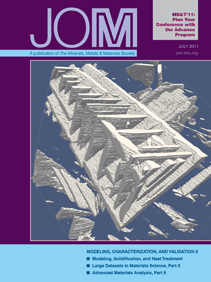 |
TMS ONLINE | TMS PUBLICATIONS | SITE MAP JOM Material Matters Articles in Full-Text Format: February 2006 |
Exploring traditional, innovative, and revolutionary issues in the minerals, metals, and materials fields. |
|||||
| OUR LATEST ISSUE | |||||
VISIT THE JOM COVER GALLERY
|
Court Rules on Patentability Standards for Composition RangesArnold B. SilvermanIn the recent In re Harris case, the Court of Appeals for the Federal Circuit set forth the standards to be employed in determining patentability of composition ranges over prior art. The court affirmed the U.S. Patent and Trademark Office (PTO) rejection of all of the claims over the prior art on the grounds that the disclosed ranges of prior art rendered obvious the claims of a pending patent application. The specific patent application involved a superalloy for turbine engines. The legal guidance provided, however, is equally applicable to composition ranges of alloys, chemical compositions, and other ranges, such as times, pressures, and temperatures, for example. It is common for prior art, such as prior patents and prior publications, to present composition ranges which either overlap the ranges claimed in a particular patent application claim or fully embrace the same. For example, in the Harris case, the claimed composition contained 13 elements. The cited prior art reference disclosed ranges, element by element, overlapping all 12 of the alloying constituents and in all but one case fully embracing the range recited for the alloying constituents. The court ruled that the PTO had the burden of providing a prima facie (initial) case of obviousness over the cited prior art patent. The court ruled that where there is overlap in ranges, the PTO’s initial burden had been met. In the present case, the prior art fully embraced each of the ranges but one, which overlapped the claimed range for that element. One way the applicant can counter the PTO obviousness rejection is to present comparative test data showing that the claimed ranges produced results that would have been unexpected by one skilled in the art, such as by showing improved properties which the prior art did not have. Another point that can be argued is that there was no motivation to make what otherwise might appear to be obvious changes in going from the prior art disclosure to the application’s claimed invention. In evaluating comparative data, it is important to be thorough and accurate in testing both the prior art technology and the technology of the invention. In determining if unexpected results have been attained by the invention, the relationship between the data and ranges to be claimed must be evaluated. In order to support the unexpected result argument, the test data must not only show meaningful differences between the prior art and the invention sought to be protected, but also the data must be correlated with the application’s claimed ranges. Where the prior art discloses a range that fully embraces a narrower patent application range, it is important to establish by data the criticality of the upper and lower limits of the range of application claims. A further argument made on behalf of the applicant in the Harris case was that the prior art “taught away” from the claimed invention (i.e., that one skilled in the art would be led in a different direction). The applicant, in making this argument as to chromium, relied on a minor difference in the numerical ranges. The court noted that the applicant’s claimed range of about 4.3% to 5.3% chromium overlapped with the prior art, which taught an additive amount of chromium of 5 weight percent to 14 weight percent. This overlapped with the upper portion (5.0% to 5.3%) of the applicant’s claimed range for chromium. The applicant argued that the prior art’s preferred range of 5.5% to 7% was outside the scope of applicant’s claimed range. The court concluded that the use of the term “about” preceding the range showed that the applicants did not intend to limit the range to its exact end points and, therefore, 5.5% as a lower limit in the prior art preferred range was not necessarily outside the scope of applicant’s claimed upper limit of “about 5.3%.” It is generally desirable to use the term “about” preceding claim ranges to provide flexibility in assertion of the patent against infringers. The court suggested that if the applicant were unable to show unexpected results or teaching-away or otherwise distinguish the pending claims over the applied prior art, the applicant could have narrowed its claims to enhance differences over the prior art. In summary, it is important to bear in mind when comparing the ranges of composition claims with prior art whether through overlap of ranges of one or more constituents or the ranges being fully embraced by the prior art, what evidence will be available to counter a rejection based upon obviousness over prior art. The ultimate determination of what would be obvious to one skilled in the art is a legal conclusion which is based upon underlying finding of facts. Evidence of unexpected results through comparative data, a teaching-away, or an amendment to the claims and other factors may be employed in seeking to overcome a rejection on this basis. Arnold B. Silverman is chair of the Intellectual
Property department and a member of Eckert
Seamans Cherin & Mellott, LLC in Pittsburgh,
Pennsylvania. |
Copyright © 2006 by The Minerals, Metals & Materials Society.
Direct questions about this or any other JOM page to jom@tms.org.
